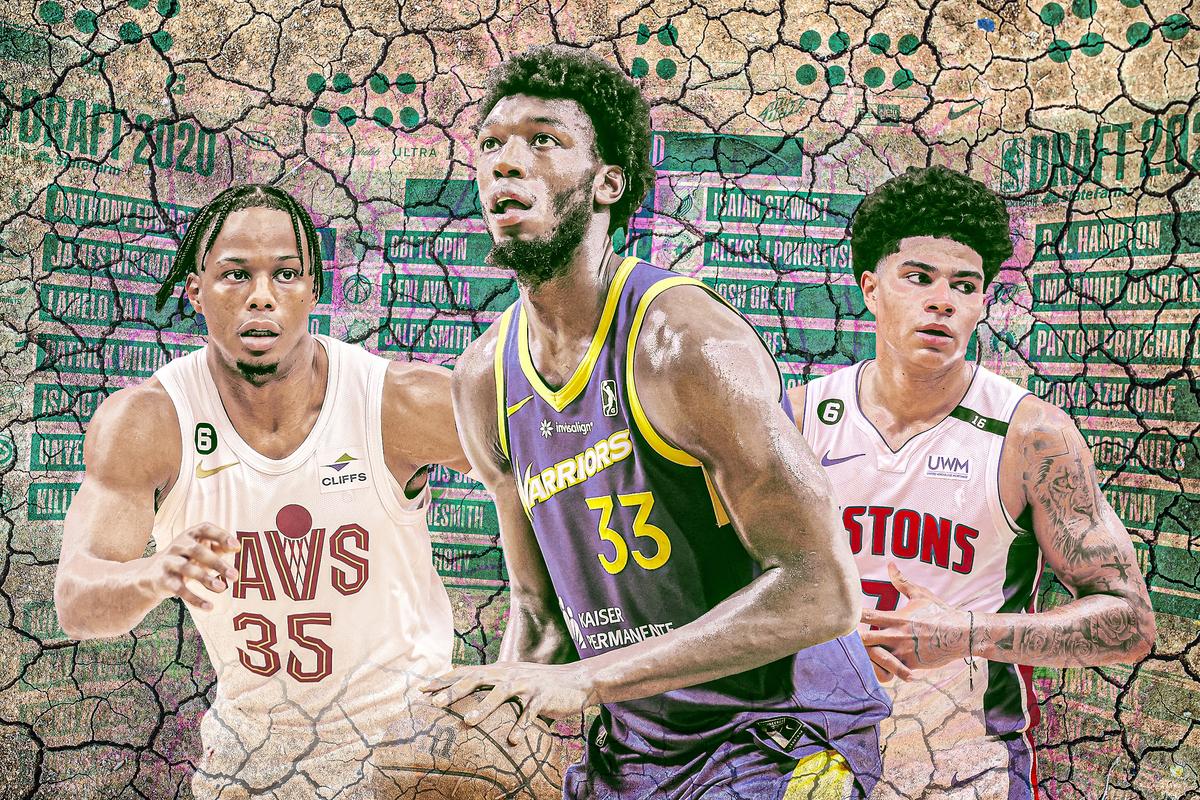
Editor’s note, Friday, December 16: Steve Kerr said before Friday night’s game that James Wiseman will play against the 76ers in light of injuries to other players.
When the Golden State Warriors play in Philadelphia on Friday in a matchup of championship contenders, James Wiseman won’t take the court. That’s because the 2020 draft’s no. 2 pick is currently in the G League and has appeared in just two NBA games, spanning 14 total minutes, since early November.
Wiseman’s path hasn’t been easy. He played just three games in college due to NCAA eligibility issues, he faced a truncated adjustment period to the NBA due to the pandemic, and he missed the entire 2021-22 season due to injury. Yet even those caveats can’t explain how much worse the Warriors have played with Wiseman on the floor: Over his career, the 7-footer ranks 755th out of 775 players in RAPM, a plus-minus stat that adjusts for teammates and opponents.
But at least Wiseman has company from his fellow draft classmates so far down the RAPM rankings. One of the only players below Wiseman is Killian Hayes, the seventh pick in 2020, who ranks 763rd. Patrick Williams, the no. 4 pick, isn’t much better in 721st place.
Every draft has its busts. Even the best-remembered, most decorated drafts of all time have players who don’t fit alongside the Hall of Famers, like Sam Bowie in 1984 or Darko Milicic in 2003. But the 2020 draft stands out because of just how many highly touted prospects faltered upon reaching the NBA.
Compared to the expected value of each draft slot through three seasons—read more about this calculation here—almost every player picked in the top 10 in 2020 has fallen short thus far.
2020 Draft Top 10
Let’s start with the draft’s positives, if only because it’s more fun to celebrate success than to rue failure. No. 3 selection LaMelo Ball earned his first All-Star nod last season and looks like a future star, as all his top statistical comps are Hall of Famers. Top pick Anthony Edwards—a relatively contentious no. 1 choice at the time—also brims with promise, even if his development has stalled this season amid the dreary discontent in Minnesota. He falls short of expectations mainly because most no. 1 picks are spectacular early in their careers, setting a high bar for comparison. From the start of the lottery era through the 2019 draft, 54 percent of no. 1 picks made an All-Star or All-NBA team within three seasons; Edwards seems unlikely to reach either mark.
Neither Ball nor Edwards is the best player from the 2020 draft, however. To find the top dog requires venturing outside the top 10—much like how the 2013 draft, with Giannis Antetokounmpo, saw its best player come off the board with the 15th pick.
Best 2020 Draftees
This chart of the top players in the 2020 draft demonstrates two patterns. First, the order of this draft class doesn’t really matter—in fact, the correlation between pick number and WAR for players selected in the first round in 2020 is 0.08, which means no discernible relationship. (If anything, the slight positive correlation means players picked later in the round have more value than players picked earlier so far.)
Second, the five players from this class with the most career WAR to date are all guards. Add in Devin Vassell (no. 11 pick) and Tyrese Maxey (no. 21) and it’s not hard to argue that guards make up the top seven 2020 draftees. (Quickley almost certainly wouldn’t rank no. 2 by anyone’s subjective rankings, but advanced metrics that incorporate plus-minus data absolutely adore the Knicks guard, as New York has been much better with Quickley on the floor every season of his career.)
That oddity seems like a fluke of the 2020 class; Scottie Barnes (2021 draft), Evan Mobley (2021), and Paolo Banchero (2022) have shown that young wings and bigs can excel, too, as long as they boast the requisite on-ball skills to succeed in the modern NBA. But for the 2020 draft class, all the non-guards have stumbled to varying degrees, no matter their pedigree.
None of the four big men taken in the draft’s top 10 have made much of a positive impact. Wiseman is in the G League, unable to help the reigning champions bridge their aging core to a new era. The Suns didn’t even pick up Jalen Smith’s third-year option, making him the first top-10 pick since Joe Alexander from the 2008 draft with that distinction. And while the Hawks’ Onyeka Okongwu and the Knicks’ Obi Toppin have both flashed potential in spurts, neither athletic big has managed to seize more playing time or take noticeable steps forward this season.
The ostensible 3-and-D wings haven’t panned out, either, with their offensive limitations offsetting any defensive prowess they might exhibit. Williams has shouldered a tremendous defensive burden on a Bulls team whose three best players are all offense-first All-Stars. In his career, Williams has guarded Giannis Antetokounmpo for the most defensive possessions and Zion Williamson for the second-most; other All-Stars like Jayson Tatum, Jimmy Butler, Kevin Durant, and Kawhi Leonard also rank among Williams’s 10 most frequent defensive matchups, according to Second Spectrum.
Yet on offense, Williams often disappears from the Bulls’ actions, floating for long stretches without any involvement on the ball. With a mere 15 percent career usage rate and more turnovers than assists, Williams hasn’t earned the trust of coach Billy Donovan, who’s spent the season shuffling him in and out of the starting lineup. Williams’s passivity is perhaps best exemplified by this shooting stat: Williams is an excellent 3-point shooter, ranking sixth among all active players with a 42 percent career rate from distance (min. 200 attempts), but he takes less than half as many 3s as any other player in the top 10. Williams is mostly drilling open looks at this point, but his percentages suggest he should at least be looking for his own shot more than he is.
Best Active 3-Point Shooters
That same imbalance appears to a lesser extent with the Wizards’ Deni Avdija, a solid defender who touts a career 15 percent usage rate and a rickety jump shot (career 31 percent from 3), and with Isaac Okoro, who’s guarded everyone from Trae Young to Pascal Siakam this season but is even less of an offensive threat.
Okoro’s stall has the potential to influence the title race this season. The Cavaliers are a legitimate contender with four solid starters but no clear answer at the small forward spot. Theoretically, a recent top-five pick would be the perfect candidate to fill that hole. Yet on a per-game basis, Okoro ranks only 10th on the Cavaliers in minutes, points, and field goal attempts. Just among Cavaliers forwards, he plays less than Cedi Osman (picked in the second round in 2015), Dean Wade (undrafted), and Lamar Stevens (undrafted).
Yet it’s hard to argue that Okoro deserves more run because he’s such a liability on offense. Averaging just four points per game, Okoro is shooting 24 percent on 3-pointers this season, despite taking the third-easiest set of attempts—based on factors like defender distance—in the league, according to Second Spectrum.
The last guard selected near the top of the 2020 draft also needs a considerable offensive boost if he’s to fulfill his promise. Hayes, much to my colleague Kevin O’Connor’s chagrin, is the NBA’s least efficient scorer, as his career 45 percent true shooting percentage is the worst mark in the entire NBA (min. 750 attempts) since he debuted. And even as Hayes has received more opportunities this season with Cade Cunningham injured, he hasn’t turned a corner. Despite the occasional outburst—he recently torched the Mavericks and Hornets in overtime!—Hayes is in last place among qualified players in true shooting percentage this season, too.
Suffice to say, none of those outcomes represents what teams hoped for when they set their sights on a top-10 pick a few years ago. I’ve written many times about how draft prospects—even highly touted ones who go in the high lottery—often fail to meet the lofty expectations placed upon them by fans and analysts. But even by that standard, whether because of the difficulties in scouting perpetrated by the pandemic, or because sometimes, randomly, a draft class is hard to judge, the 2020 draft falls well short.
Consider, by way of comparison, how the next draft after 2020 looks at the moment. The 2021 draft packed almost all of its best players at the top, as it should: The 2021-22 All-Rookie First Team included the first four picks (Cunningham, Jalen Green, Mobley, and Barnes), plus no. 8 pick Franz Wagner.
Instead, the 2020 draft looks more reminiscent of 2015, another outlier in typical draft outcomes. The only players from that class to make an All-NBA team are Karl-Anthony Towns (the no. 1 pick) and Devin Booker (no. 13), who fit the Edwards and Haliburton roles in this analogy. No. 4 pick Kristaps Porzingis excelled early in his career, then was waylaid by injuries, which makes him a semi-match for Ball. Otherwise, the top of the 2015 draft was full of underachievers like Jahlil Okafor (no. 3), Mario Hezonja (no. 5), Emmanuel Mudiay (no. 7), and Stanley Johnson (no. 8).
Through three seasons, the only players from the top 10 in the 2015 draft who beat expectations were Towns and Porzingis, much like how Ball is the only such player from 2020:
2015 Draft Top 10 Through Three Seasons
Almost all of those players taken high in 2015 are no longer with their original teams, but the broad failure of the 2020 draftees to meet expectations still reverberates for the franchises that drafted them. At this season’s trade deadline, the Warriors might use Wiseman as fodder for a deal, giving up on the sunk cost of the no. 2 pick, because he can’t provide solid minutes in the middle by himself. The Cavaliers might try for a wing upgrade because Okoro isn’t a reliable contributor. And teams like the Bulls and Hawks could offload veterans to clear more playing time for Williams and Okongwu, respectively, because they need to see what they have in their youngsters before they’re up for extensions next summer.
All of those players are still young, and some might emerge as more productive NBA players as they age and gain more game experience. But for now, the 2020 draft class is a stark reminder that forecasting prospects is always hard.

